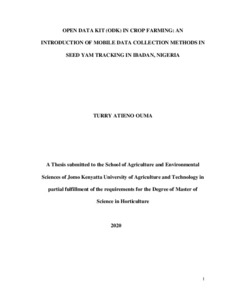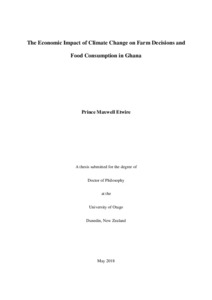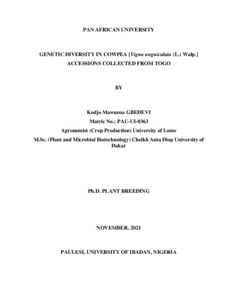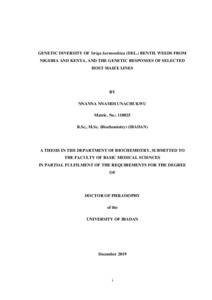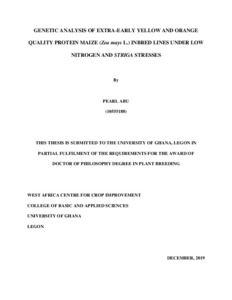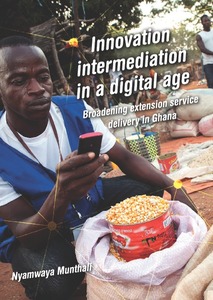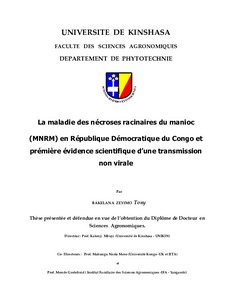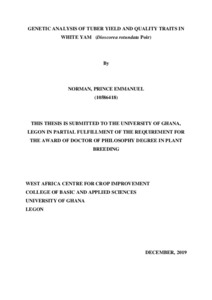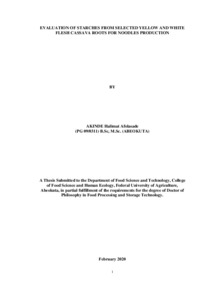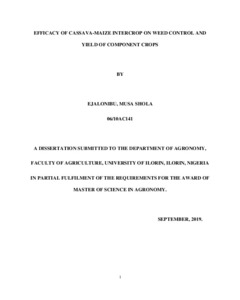Welcome to the International Institute of Tropical Agriculture Research Repository
Theses and Dissertations: Recent submissions
Now showing items 61-80 of 81
-
Open Data Kit (ODK) in crop farming: an introduction of mobile data collection methods in seed yam tracking in Ibadan, Nigeria
(Jomo Kenyatta University Of Agriculture And Technology, 2020)The purpose of this paper is to illustrate the importance of applying open-source technologies for mobile-based data collection for real-time tracking of seed yam (Dioscorea rotundata and Dioscorea alata) production. Seed yam data in Nigeria have been predominantly collected using field notebooks in the past, which were subsequently entered into a Microsoft Excel spreadsheet or Access database for analysis and reposition. Relevant areas of weakness within the current data systems include time delay ... -
The economic impact of climate change on farm decisions and food consumption in Ghana
(University of Otago, 2018-05)Climate change poses a serious threat to the growth of developing countries, especially Ghana where the majority of people derive their livelihoods directly from agriculture and related industries. This thesis sets out to examine the economic impact of climate change on agriculture by modelling climate, household, and farm data from Ghana. The impact is assessed through three connected empirical studies. In our first empirical study, we estimate a multinomial logit (8,700 observations) in order ... -
Genetic diversity in cowpea [Vigna unguiculata (L.) Walp.] accessions collected from Togo
(2021-11)Cowpea is one of the most widely grown legumes in Togo for its grains and leaves, which are used both as food and feed. Despite its importance in the nutrition and economic life of the people, bulk of the varieties grown in Togo are landraces. Genetic improvement of crops requires the presence of heritable genetic variation. However, there is hardly any information on the extent of variability among cultivated cowpea in Togo. This study was carried out to assess the phenotypic and molecular diversity ... -
Genetic diversity in cowpea [Vigna unguiculata (L.) Walp.] accessions collected from Togo
(2021-11)Cowpea is one of the most widely grown legumes in Togo for its grains and leaves, which are used both as food and feed. Despite its importance in the nutrition and economic life of the people, bulk of the varieties grown in Togo are landraces. Genetic improvement of crops requires the presence of heritable genetic variation. However, there is hardly any information on the extent of variability among cultivated cowpea in Togo. This study was carried out to assess the phenotypic and molecular diversity ... -
Genetic diversity of Striga hermonthica (Del.) benth. weeds from Nigeria and Kenya, and the genetic responses of selected hist maize lines
(University of Ibadan, 2019-12)Striga hermonthica (SH) is a parasitic weed that attacks and significantly reduces the yield of maize in Africa. The genetic interactions responsible for resistance or susceptibility of hosts to the parasite and the genetic differentiation that exists between and within SH populations are not fully known. This study investigated the genetic diversity of SH populations in the largest maize producers in Sub-Saharan Africa (Kenya and Nigeria) and; the genetic responses of a susceptible (5057) and a ... -
Genetic analysis of extra-early yellow and orange quality protein maize (Zea mays L.) inbread lines under low nitrogen and Striga stresses
(University of Ghana, 2019-12)Low soil nitrogen (low-N) and Striga hermonthica (Del.) are major constrains hampering maize production in sub-Saharan Africa (SSA). Developing extra-early quality protein maize (QPM)-provitamin A hybrids that combine low-N tolerance with Striga resistance is crucial for addressing the food security and undernourishment challenges in SSA. The objectives of this study were to i) assess the genetic diversity among a group of extra-early yellow QPM and orange QPM-provitamin A maize inbred lines, ii) ... -
Digitalization of smallholder value chain lending partnerships: an interplay of trust and inclusion
(Wageningen University and Research Center, 2021) -
Contribution a la gestion agroecologique de Maruca vitrata Fab. et d'autres insectes ravageurs majeurs de la culture du niebe (Vigna unguiculata L. Walp.) dans les regions de Zinder et Maradi au Niger
(Universite Dan Dicko Dankoulodo De Maradi, 2020)Au Niger, le niébé (Vigna unguiculata L. Walp.) est une culture alimentaire importante mais son rendement est bas en raison de plusieurs contraintes biotiques et abiotiques. L’objectif de cette thèse est d’améliorer le rendement du niébé par la mise en place d’une stratégie écologique de lutte contre les principaux insectes ravageurs de la culture. Les activités suivantes ont été conduites : une enquête de base dans 19 villages des régions de Maradi et Zinder pour identifier les principales ... -
Innovation intermediation in a digital age: broadening extension service delivery in Ghana
(Wageningen University and Research Center, 2020)Classical extension focuses on linear transfer of technology. Globally, and in Ghana particularly, we have seen attempts to address the linearity of classical extension with the shift to broader extension service delivery approaches. From an innovation systems perspective innovation intermediation is suggested for extension organisations to function more effectively and respond to wider agricultural system constraints. This involves three broad facilitation roles which are demand articulation, ... -
Genetic analysis of tuber yield and quality traits in white yam (Dioscorea rotundata Poir)
(University of Ghana, 2019-12)The genetic progress in tuber yield and quality attributes of yam is constrained by prolonged breeding cycle, complex ploidy (2n=40, 60, 80), high heterozygousity, complex flowering pattern (dioecois and monoecious flowering and shy to flower), multi-species, low propagation ratio, biotic and abiotic factors. Genetic improvement of yam with high tuber yield, high dry matter content, starch and other food quality attributes using traditional and modern breeding techniques will contribute to the ... -
Interseeding timing of cowpea (Vigna unguiculata L. Walp.) living mulch on weed diversity, physical soil properties and performance of maize (Zea mays L.)
(University of Development Studies, 2019)This trial was conducted to determine cowpea living mulch and maize maturity type effect on soil physical properties, maize yield and weed management. The study was a 3 x 4 factorial experiment laid out in Randomised Complete Block Design with 3 replications. Three maize maturity types: extra early Abontem, early Omankwa and medium Obatanpa and four living mulch systems: cowpea living mulch interseeded same day with maize (SDWM), cowpea living mulch interseeded 1 Week after planting maize (WAPM), ... -
Evaluation of starches from selected yellow and white flesh cassava roots for noodles production
(Federal University of Agriculture, Abeokuta, 2020)Cassava starch has been prospected in many food products manufacture. However, its suitability for making starch noodle has not been reported. Hence, this study was conducted to determine cassava starch‘s suitability in starch noodles production. The study was based on a completely randomized design with cassava variety as the main source of variation. The physicochemical properties [paste clarity (PCL), gel strength (GS), retrogradation], amylose content (AC), thermal properties [onset temperature, ... -
Productivity, water use and climate resilience of alternative cocoa cultivation systems
(Georg-August-University of Gottingen, 2017-12)Global demand for cocoa beans is projected to keep rising while future production is likely to be limited by climate variability and change. Over 70% of the global cocoa supply comes from West Africa, a region expected to be greatly affected by climate change and extreme droughts. Cocoa production in West Africa needs to be adapted to more marginal and extreme climatic conditions, mainly drought, to sustain production and avoid further deforestation of the remaining rainforest for its cultivation. ... -
Efficacy of cassava-maize intercrop on weed control and yield of component crops
(University of Ilorin, 2019)Low yield of maize/cassava intercrop is majorly due to some identified constraints like poor density of component crops, inappropriate application of fertilizer and weed infestation. This study was conducted in Otukpo-Icho, southern Guinea savanna of Nigeria and Igbariam, Humid Tropical Forest of Nigeria during 2018/2019 cropping season to determine the weed control efficiency and performance of cassava/maize intercrop. The trials were laid out as randomized complete block design in a factorial ... -
Genetic analysis of resistance to Radopholus similis in Banana
(Makerere University, 2019-12)Banana is an important crop worldwide mostly grown in tropical and subtropical regions, of annual production is 145 million metric tons valued at 26.5 billion Euros. Banana production is threatened by various constraints including pests and diseases. Among the pests, Radopholus similis is the most destructive species. East African Highland Bananas mostly grown in Uganda and other parts of East Africa are highly susceptible to this species with yield reduction reaching 80%. Breeding for resistance ... -
Responses of the Ethiopian fruit fly, Dacus ciliatus (Diptera, Tephritidae) to colored rectangles, spheres, and ovoids
(2004)On the Mascarene Islands, the Ethiopian fruit fly, Dacus ciliatus Loew, is one of the major frugivorous pests of Cucurbitaceae. Both visual and olfactory signals involved in the host location process need to be evaluated to better understand the behaviour of this species, and to improve trapping. This article reports results of our studies with visual stimuli. Responses of immature and sexually mature females and males were studied in two outdoor field cages. The reaction of cohorts of 150 adults ... -
Genetic analysis of host plant resistance to the cassava mosaic disease
(2002)The genetic control of resistance to the cassava mosaic disease (CMD) in some African landraces, their relationship with the widely used resistant genetic stock, clone 58308, and molecular markers associated with resistance to CMD in the landraces were evaluated in this study. The F-i progenies of 54 cassava crosses and their parents (clone 58308, six improved clones and 15 African landraces) were evaluated in two genetic experiments in three environments in Nigeria. Genetic analysis revealed that ... -
Economic evaluation of adoption of improved soybean production and utilization technologies in Kaduna and Kano States Nigeria: P.hD. thesis
(2006)Low yield, persistent pod shattering and susceptibility 10 pests and diseases characterize the cultivation of traditional soybean varieties in Nigeria. Research has, however, developed new improved variety of soybeans, like TGx 1448-2E that is cultivated in Kaduna and Kano States. Local food items that incorporate soybeans are equally used to improve the nutritional value of foods. This study investigates the socio-economic lac tors that influence the adoption of improved soybean innovations, ... -
Capital market operations in an emerging economy: the case of Nigeria
(2008)One of the key challenges facing big businesses is how to secure the huge financing they need to invest in their businesses. From banking, insurance, pharmaceuticals, conglomerates, oil and gas companies and every other sector of the economy, the story is the same. Everyone faces the challenge of funds generation for executing their developmental projects and generally keeping the engine of their businesses running. The government, in a bid to solve this problem, established the Nigerian Securities and ...

